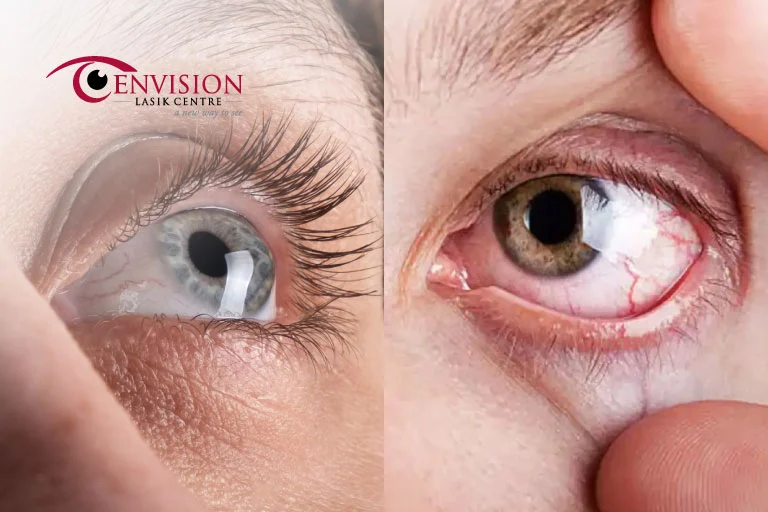What is the correlation between keratoconus and Dry Eye Disease?

AUTHOR
Ophthalmologist/ Eye Surgeon 13+ Years Exp
MBBS, MS – Ophthalmology
TSMC- TSMC/FMR/05251 (2018)
CONDITION
CALL US 24/7 FOR ANY HELP
GET IN TOUCH ON
If you’re here, chances are you have questions about keratoconus, dry eye disease, or both. Maybe you’ve heard they’re connected somehow, or you’re experiencing symptoms of both and wondering if that’s a coincidence.
Whatever brings you here, you’re in the right place! We’re going to have a thorough discussion about how these two conditions overlap, how they’re connected, and what you can do to manage them. By the end of this blog, you’ll have clarity and actionable steps to take care of your eyes.
Grab a cup of tea (or your favorite drink), and let’s get into it.
What’s the Deal With Keratoconus and Dry Eye Disease?
Before we explore their relationship, let’s break down these conditions one by one.
- Keratoconus is when the cornea (the clear front part of the eye) becomes thin and bulges into a cone-like shape. This distortion leads to blurry or distorted vision because the cornea isn’t smooth and round anymore.
- Dry Eye Disease (DED) happens when your eyes don’t make enough tears, or your tears evaporate too quickly. This leaves your eyes feeling dry, gritty, and irritated.
Now, here’s the interesting part. These conditions often show up together, almost like unwelcome guests at a party. While not everyone with keratoconus will experience dry eye disease and vice versa, research shows there’s definitely a connection.
How Are They Connected?
- Structural Changes in the Cornea
For starters, think about what keratoconus does to the cornea. The thinning and bulging make the surface irregular, and this irregular surface can disrupt how tears spread across your eye with every blink. If your tears aren’t coating your cornea evenly, your eyes can dry out. - Contact Lenses as a Factor
Many people with keratoconus rely on specialized contact lenses, like scleral lenses, to see clearly. While these lenses are a lifesaver for vision, they can block oxygen flow to the cornea and sometimes trap debris, both of which can make dry eye symptoms worse. - Eye Rubbing
Excessive eye rubbing is common in people with keratoconus because of discomfort or itchiness. Unfortunately, rubbing not only worsens keratoconus over time but also irritates the surface of your eyes, contributing to dryness and inflammation. - Inflammation
Both keratoconus and dry eye disease involve inflammation. With dry eye, the lack of a healthy tear film can lead to chronic irritation and inflammation. This inflamed environment can worsen keratoconus or at least make managing it more frustrating. - Meibomian Gland Dysfunction (MGD)
Here’s another layer. MGD, a condition where the glands in your eyelids don’t produce enough oil to keep your tears from evaporating, is a common cause of dry eye. Interestingly, people with keratoconus are more likely to have MGD as well.
Shared Symptoms of Keratoconus and Dry Eye Disease
One of the challenges is that keratoconus and dry eye have overlapping symptoms, making it tricky to pinpoint the cause of your discomfort. Here’s what they share:
- Blurry or fluctuating vision.
- Sensitivity to light (hello, sunglasses!).
- A gritty or foreign body sensation in the eyes.
- Eye fatigue or strain, especially after screen time or reading.
- Excessive watering (yes, watery eyes can still mean dryness).
Do these sound familiar? If they do, you’re not alone. The good news is, understanding these symptoms is the first step toward managing them effectively.
Managing Keratoconus and Dry Eye Disease Together
Now for the part you’ve been waiting for – how to manage these two conditions. It’s no secret that juggling both can feel overwhelming, but remember, there’s a lot you can do to find relief.
1. Specialized Eye Care Is Key
Having a good optometrist or ophthalmologist is a game-changer. Tell them about all your symptoms, not just one condition or the other. They’ll be able to create a comprehensive treatment plan to address both issues.
2. Use the Right Lenses
For keratoconus, scleral lenses are often the go-to choice because they don’t rest directly on your cornea. Plus, they create a fluid reservoir that can help keep your eyes hydrated. It’s like giving your eyes a tiny moisturizing pool to swim in all day!
But here’s the kicker. These lenses can take some getting used to, and they need to be fitted properly to avoid worsening dryness.
3. Tackle Dry Eye at Its Source
Addressing dry eye disease alongside keratoconus is crucial. Here are some strategies you can try (with your doctor’s guidance):
- Eye Drops – Preservative-free artificial tears can soothe irritation. For more serious dryness, your doctor might recommend prescription drops like cyclosporine (to reduce inflammation).
- Lid Hygiene – Keeping your eyelids clean and free of debris can improve tear quality. Warm compresses can also help with MGD.
- Punctal Plugs – These tiny plugs inserted into your tear ducts can help tears stay on your eyes longer.
- Omega-3 Supplements – Adding omega-3 fatty acids to your diet has been shown to support healthier tear production.
4. Stop Rubbing Your Eyes
This one’s tough, but it’s absolutely critical. If you’re prone to rubbing due to irritation, talk to your doctor about ways to reduce the urge, like using lubricating eye drops or allergy medications.
5. Protect Your Eyes
Wear wraparound sunglasses to shield your eyes from wind, dust, and UV rays. These external irritants can worsen both keratoconus and dry eye.
6. Consider Corneal Collagen Cross-Linking (CXL)
If you’re eligible for CXL, it can stabilize keratoconus and prevent further progression. While it doesn’t directly treat dry eye, stabilizing the cornea may indirectly help improve tear film stability.
7. Hydrate and Humidify
Make sure you’re staying hydrated by drinking enough water. Invest in a humidifier to keep the air around you moist, especially during the winter or in air-conditioned spaces.
Don’t Ignore the Warning Signs
If left untreated, both keratoconus and dry eye disease can significantly impact your quality of life. Untreated keratoconus can lead to severe vision loss, and chronic dry eye can damage the surface of your eyes over time. Don’t brush off the symptoms or talk yourself into thinking it’s “no big deal.”
Take Action for Your Eye Health
Managing keratoconus and dry eye disease can feel like navigating uncharted waters, but you don’t have to go it alone. The first step is consulting a eye specialist who can guide you toward the best treatment options for your unique situation.
Your eyes deserve proper care, and so do you. Schedule a visit to an eye doctor today, ask all your questions, and together, find a solution that works. The road to healthier, happier eyes starts now!
AUTHOR
Ophthalmologist/ Eye Surgeon 13+ Years Exp
MBBS, MS – Ophthalmology
TSMC- TSMC/FMR/05251 (2018)
CONDITION
CALL US 24/7 FOR ANY HELP
GET IN TOUCH ON



